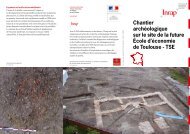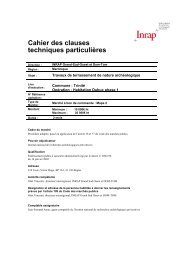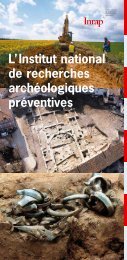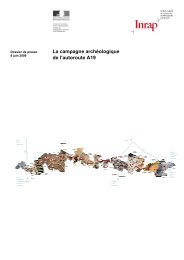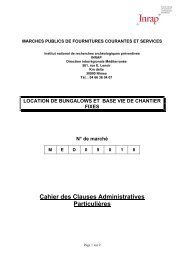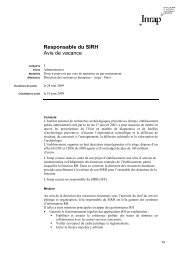Vestiges de la traite négrière - Inrap
Vestiges de la traite négrière - Inrap
Vestiges de la traite négrière - Inrap
You also want an ePaper? Increase the reach of your titles
YUMPU automatically turns print PDFs into web optimized ePapers that Google loves.
Introduction<br />
In recent years, the history of s<strong>la</strong>very has taken an important new turn.<br />
However, new <strong>de</strong>velopments in the archaeology of the colonial period are not<br />
as wi<strong>de</strong>ly known. Yet, archaeology p<strong>la</strong>ys a key role in documenting the living<br />
conditions of the s<strong>la</strong>ves, their habitats, the settlements where they were ens<strong>la</strong>ved<br />
–their foundations remain even if they have often been <strong>de</strong>stroyed–, maroon<br />
enc<strong>la</strong>ves, burial rites, their state of health at the time of <strong>de</strong>ath, as well as their<br />
age, gen<strong>de</strong>r, etc. The information we can unearth from the ground provi<strong>de</strong>s<br />
us with unique data: written archives, where they exist, are for the most part<br />
univocal, since they were composed by the state, or by s<strong>la</strong>ve tra<strong>de</strong>rs or owners.<br />
Archaeology –in particu<strong>la</strong>r, preventive archaeology, for the <strong>la</strong>st twenty years–<br />
can make a crucial contribution to the study of colonial s<strong>la</strong>very by investigating<br />
the material culture of the s<strong>la</strong>ves. This evi<strong>de</strong>nce benefits our un<strong>de</strong>rstanding<br />
of the tra<strong>de</strong>, the habitats, the everyday life, and the funerary practices of the<br />
s<strong>la</strong>ves, as well as “marronnage”. Recent excavations in Brazil, in eastern<br />
and southern Africa, and in Ghana, together with un<strong>de</strong>rwater research, have<br />
yiel<strong>de</strong>d important data on the s<strong>la</strong>ve tra<strong>de</strong>. Although s<strong>la</strong>ve quarters –so-called<br />
“b<strong>la</strong>ck shack alleys”– have almost all disappeared, they remain, as it were, in<br />
un<strong>de</strong>rground archaeological structures which are of great historical interest.<br />
Works un<strong>de</strong>rtaken in Louisiana, Cuba, the French Caribbean, Brazil, and Cape<br />
Ver<strong>de</strong> have renewed the avai<strong>la</strong>ble documentation on the habitats and material<br />
culture of the s<strong>la</strong>ves. Although it can be challenging for archaeologists, the study<br />
of “marronnage” is thriving in the United States, Cuba, Brazil, Reunion, and<br />
Mauritius. Research done on “cemeteries” in the United States, Gua<strong>de</strong>loupe,<br />
Martinique or Reunion has thrown new light on the burial conditions of the<br />
s<strong>la</strong>ves and on their characteristic pathologies (dietary <strong>de</strong>ficiencies, tooth <strong>de</strong>cay,<br />
infections, <strong>de</strong>generative diseases…).<br />
From case studies to synthetic approaches to s<strong>la</strong>very in the United States,<br />
Barbados, Cuba, Brazil, Colombia, the French West Indies, and Cape Ver<strong>de</strong>, as<br />
well as eastern, southern, and western Africa, and the is<strong>la</strong>nds of Reunion and<br />
Mauritius, this conference will review recent advances in our knowledge of the<br />
s<strong>la</strong>ve tra<strong>de</strong>, s<strong>la</strong>very, and “marronnage”, while also making the case for a better<br />
appreciation of archaeological perspectives on the heritage of s<strong>la</strong>very, and its<br />
conservation and enhancement.<br />
7



